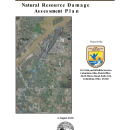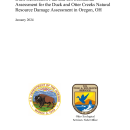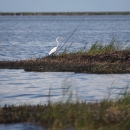States
OhioOverview
This case addresses natural resource injuries that have occurred due to the release of hazardous substances. The federal Trustee is studying the adverse effects of the contaminants on Duck and Otter Creeks (collectively the “Creeks”) through a process known as Natural Resource Damage Assessment and Restoration (NRDAR), pursuant to the Comprehensive Environmental Response, Compensation and Liability Act, 42 U.S.C. 9601 et seq.
The Creeks are two adjacent creeks in the larger urbanized Maumee River watershed in Northwestern Ohio. The Creeks lie just east of the Maumee River, and both flow into Maumee Bay on Lake Erie. Decades of industrial activities in the vicinity of the Creeks have led to releases of hazardous substances into the watershed contaminating soils, sediments, and surface water. Contaminants of concern in the Creeks include polycyclic aromatic hyrdrocarbons (PAHs), polychlorinated biphenyls (PCBs), metals (including arsenic), and other organic contaminants.
Trustees
The Trustee for federal natural resources is the U.S. Department of the Interior, acting through the Fish and Wildlife Service. The Trustee initiated a natural resource damage assessment (NRDAR) in 2010 under the Comprehensive Environmental Response, Compensation, and Liability Act (CERCLA).
Assessment
Pursuant to the applicable regulations, the Trustee invited the potentially responsible parties to participate in a cooperative assessment, but they declined. The Trustees completed a Pre Assessment Screen (PAS), which is a rapid review of readily available information on the releases of the hazardous substances and potential impacts to natural resources (See 43 C.F.R. § 11.23). The Trustee determined in the PAS that an assessment was warranted. Following the PAS determination, an Assessment Plan was prepared in 2010 (See 43 C.F.R. §§ 11.30-11.38), which outlined the approaches for assessing and quantifying injuries to natural resources. The Trustee developed the Assessment Plan to begin planning for and assessing their assessment in 2010 to determine how much restoration is necessary to address harm to natural resources. Services provided by natural resources include ecosystem-based services, such as food and shelter for wildlife species.
Great Lakes Legacy Act Sediment Remediation of Otter Creek
A portion of Otter Creek was recently remediated through a public/private partnership pursuant to the Great Lakes Legacy Act (GLLA). The goal of GLLA is to accelerate contaminated sediment removal in Great Lakes Areas of Concern (AOCs) and in 2008 it was revised to include habitat restoration. However, habitat restoration does not always occur, and restoration efforts may be limited in spatial extent and not fully replace natural resources that were injured due to releases of hazardous substances.
In July 2020, a GLLA Project Agreement amendment was signed for sediment remediation between EPA Great Lakes National Program Office (GLNPO) and three industrial partners: BP Husky Refining, LLC (BP) and BP Remediation Management Services Company; Chevron Environmental Management Company; Evergreen Resources Management Operations (Evergreen or Sunoco) (collectively referred to as the Otter Group) to remediate Otter Creek. The remedial action for Otter Creek began on September 30, 2020. The remediation removed 50,400 cubic yards of contaminated sediment via hydraulic dredging from the lower 1.7 miles of Otter Creek and its confluence with Maumee Bay. The voluntary public/private partnership was funded by EPA and the Otter Group. Demobilization of the remedial site was complete on September 4, 2021.
Current Phase and Next Steps
The assessment phase of the Natural Resource Damage Assessment process is ongoing and includes actions such as injury determination, injury quantification, restoration scaling, and damage determination for Duck and Otter Creeks. Damages are measured in terms of the cost of restoration, rehabilitation, replacement, and/or acquisition of the equivalent of injured resources and their services. Damages also include the Trustee’s assessment costs and the Trustee’s costs associated with restoration planning and implementation.
Settlement
The Trustee has reached a proposed settlement with five potentially responsible parties (PRPs) on the Creeks, the Ohio Refining Company, LLC, Chevron U.S.A, Inc., Pilkington North America, Inc., Energy Transfer (R&M), LLC (formerly Sunoco), and Chemtrade Logistics, Inc. The proposed settlement resolves liability for the four Settling PRPs at the Creeks, while the United States continues to seek resolution with the remaining PRPs for damages to natural resources.
Restoration
The Trustee prepared a Draft Restoration Plan and Environmental Assessment for the Duck and Otter Creeks Natural Resource Damage Assessment in Oregon, OH (draft RP/EA) that describes how the settlement will be implemented. Under the proposed settlement, monies will be used to fund a portion of the Delaware/Clark Island Complex Restoration Project. The draft RP/EA was available for public review and comment from January 9 to February 8, 2024. No public comments were received and the Trustee released the Final Restoration Plan and Environmental Assessment for the Duck and Otter Creeks Natural Resource Damage Assessment in Oregon, OH in March 2024.
Administrative Record Index
Administrative Record is located here.






